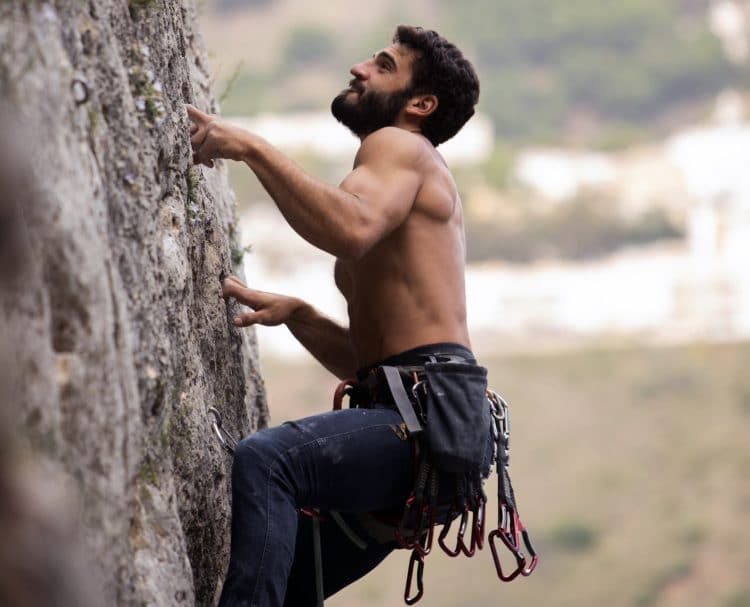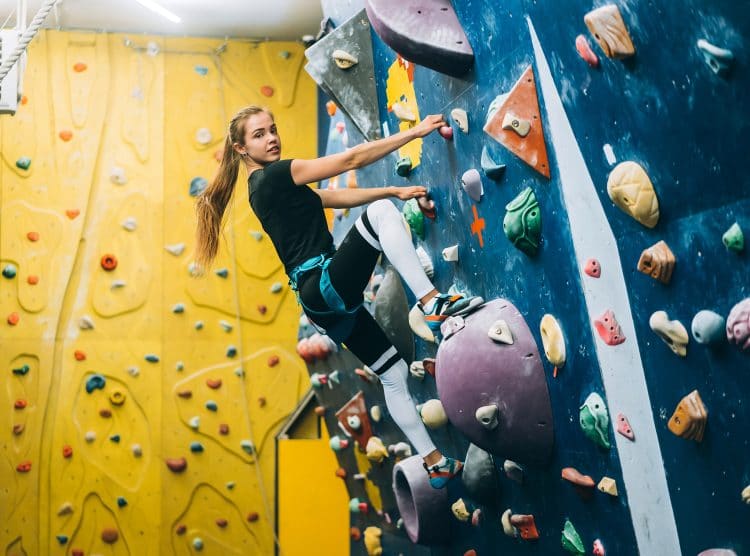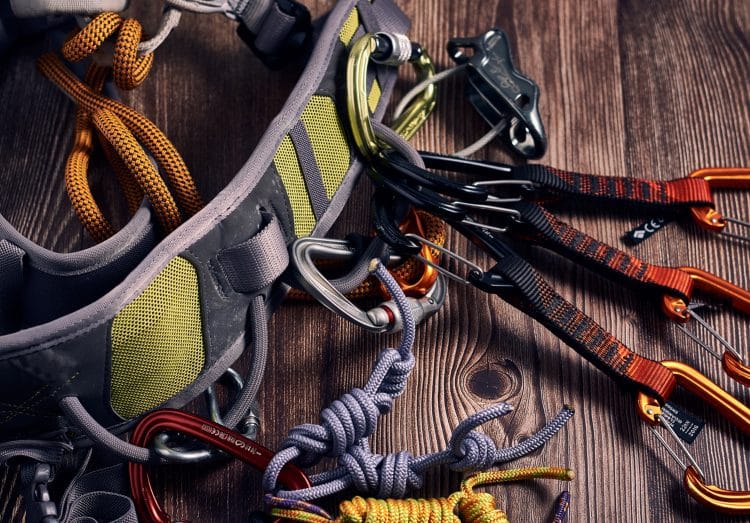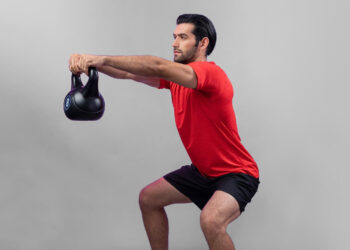Depending on the climber’s weight and the amount of rest time taken between routes, rock climbing can burn between 430 to 687 calories per hour for an individual weighing 180 pounds. In addition to burning calories, rock climbing can also help you gain strength, power, and aerobic and anaerobic fitness.
Rock Climbing Calories Burned Calculator
Calories Burned with other outdoor activities (Weight: 175lbs)
| MET | 15 mins. | 30 mins. | 45 mins. | 60 mins. | |
|---|---|---|---|---|---|
| Cycling or Biking | 9 | 188 | 375 | 563 | 750 |
| Hiking | 4.8 | 100 | 200 | 300 | 400 |
| Fishing | 3.5 | 73 | 146 | 219 | 292 |
| Horseback Riding | 5.5 | 115 | 229 | 344 | 458 |
| Kayaking | 5 | 104 | 208 | 313 | 417 |
| Skating | 9 | 188 | 375 | 563 | 750 |
| Skateboarding | 5 | 104 | 208 | 313 | 417 |
| Golf | 4.8 | 100 | 200 | 300 | 400 |
| Jogging | 9.8 | 204 | 408 | 613 | 817 |
| Rock Climbing | 8 | 167 | 333 | 500 | 667 |
How to Use The Rock Climbing Calculator
The calculator is easy and simple to use, all you must do is input 2 values, then find the activity you have done and you will find the calories you burned there. This is how you do it step-by-step.
- Choose the unit of measurement – metric (kilograms) or imperial (pounds)
- Enter your weight
- Choose Rock Climbing activity, add the number of minutes you spent rock climbing
- Select the rock climbing activity
- Hit Calculate
Now you should see the approximate number of calories that were burned while rock climbing.
How This Calculator Works
MET
This calculator uses the MET formula to calculate the number of calories burned.
The MET formula uses MET values, the amount of oxygen used by the muscles per minute, and the weight of the individual in kilograms doing the activity.
A MET value (metabolic equivalent) is a value that is the ratio between your resting metabolic rate and your active metabolic rate. Your resting metabolic rate is the same thing as your basal metabolic rate, and they both measure your energy expenditure when the body is at rest, and not actively digesting food.
Level Up Your Fitness: Join our 💪 strong community in Fitness Volt Newsletter. Get daily inspiration, expert-backed workouts, nutrition tips, the latest in strength sports, and the support you need to reach your goals. Subscribe for free!
MET values rate the energy expenditure of various activities. An activity with a MET of 1 will burn calories equal to your resting metabolic rate. An activity with a MET of 5 will burn calories equal to 5 times the energy used by an activity with a MET of 1. So, 5 times your resting metabolic rate.
The higher the MET value, the more calories are burned.
The MET formula also uses the amount of oxygen used by the muscles per minute per kilogram of bodyweight. This number is 3.5 ml.
You can calculate the amount of oxygen used by your muscles per minute by multiplying 3.5 by your bodyweight in kilograms.
MET values for the rock climbing are:
| Type of Activity | MET | Calories Burned / Hour |
|---|---|---|
| Rappelling | 5 | 430 |
| Ascending or traversing rock, low-to-moderate difficulty | 5.8 | 498 |
| Ascending rock, high difficulty | 7.5 | 644 |
| Rock or mountain climbing | 8 | 687 |
Formula
Total Calories burned in 1 minute = (3.5 x MET x bodyweight in kg)/200
Examples
A person weighing 140 pounds will burn 330-540 calories in one hour of rock climbing.
- Calories burned (per minute) = (body weight in kg x MET x 3.5) / 200
The formula will look like this for low-to-moderate difficulty rock climbing for a 140-pound person.
- (63.5029 kg x 5.8 x 3.5) / 200 = 6.455 calories burned per minute of rock climbing at low-to-moderate difficulty
To calculate the number of calories burned per hour rock climbing, you multiply the calories burned per minute by 60 (minutes)
- Calories burned per hour = 60 x 6.455
388 calories will be burned in one hour of rock climbing.
Results
A 140-pound person will burn 388 calories per hour rock climbing at a low-to-moderate difficulty. They will also burn 6.455 calories per minute rock climbing.
What is Rock Climbing?
Rock climbing is an activity and sport where an individual climbs natural rock formations like mountains or rocky walls, or artificial rocks walls made specifically for climbing.
The individual must reach the endpoint without falling. If you were to fall, a harness is around your waist and a rope is on it to catch you so that you will either slowly and safely recline to the bottom, or simply be caught in the air and not fall.
Rock climbing takes a lot of grip strength, and agility to grip onto unusual ledges and to reach the top without being afraid of falling.
There are many styles and disciplines of rock climbing. They can differentiate from climbing steep, impossible-looking walls, to boulders and artificial rock formations indoors.
Bouldering requires less equipment and uses more energy. It is rock climbing without the harnesses and with only rubber shoes and chalk. It consists of using problem-solving rather than strength to climb walls.
Level Up Your Fitness: Join our 💪 strong community in Fitness Volt Newsletter. Get daily inspiration, expert-backed workouts, nutrition tips, the latest in strength sports, and the support you need to reach your goals. Subscribe for free!
It is high difficulty compared to normal rock climbing, but it can be fun since it is less having the strength and more taking your time to climb the wall and finding your footing.
Indoor
Indoor climbing is done inside of buildings on artificial rock formations. This allows rock climbing to be done anytime, no matter the weather or time of day.
This makes indoor climbing advantageous due to weather and time restrictions. Indoor climbing can also be safer at times, with equipment and safety gear like landing gear provided for you.
The only downfall to indoor climbing is the grading of the routes can be measured differently from gym to gym, so that can make things confusing and inaccurate.
Other than that, negative, indoor climbing is a convenient and climate-friendly place to train for outdoor climbing.
Outdoor
Outdoor climbing would usually happen on days where it is sunny and dry since climbing when it is dark and slippery would prove to be more dangerous and difficult.
Having the proper equipment and basic training is key to successfully climbing an outdoor wall. Having equipment and knowing how to use it is easier than having the skills to climb the wall.
Knowing the rock climbing basics on indoor walls would give you the experience of not only climbing outdoor walls, but it will also give you a feel of what walls you are capable of climbing.
You do not want to show up to a wall and it is too difficult for you to climb, or even too easy. You should have enough experience to know what is difficult and what is not.
Equipment
Rock climbers wear specialized rubber shoes for climbing, that is smaller than normal shoes to improve sensitivity on your foot placement.
Climbing chalk is used to dry the hands and minimize sweating. This type of chalk is also used by powerlifters to have a tight grip on the weight they use.
Climbing rope is used to protect the climber from a fall. Harnesses called carabiners are used with ropes to clip into belay and rappel anchors and connecting gear. Belay devices can catch and lower climbers and rappel them down.
Bolts are now used in the sport of climbing. Bolts are anchors in rock that climbers can hook their rope along the way of climbing. Spring-loaded camming devices are now used to allow a variety of climbing styles protection while climbing.
A specialized helmet is worn by climbers to protect them from falling rocks or from crashing into rocks.
Is Rock Climbing Good for Burning Calories?
Rock climbing is a great exercise that burns many calories. Rock climbing uses the whole body, so it is an intense full-body workout each time you rock climb. Rock climbing in itself burns serious calories, but depending on different other factors can you find if it will burn many calories and help you lose weight.
To rock climb and burn many calories, you will have to climb walls that prove to be challenging for you. Easy climbing sessions will not burn as many calories as hard climbing sessions, and hard climbing sessions will use more muscle.
If you want to burn many calories, you must either climb for longer, and climb more walls in one session, or you can use extra weight to make climbing more difficult. If you are planning on carrying extra weight, you must be careful as to not put on too much weight and put yourself in danger, just a little weight should be enough.
A better idea is to simply try to get the heart rate up and climb quicker. Bouldering routes can be climbed quickly and also take more time to climb since they risk injury if you fall. It is for a high skill level, but it will be worth it since it will burn many calories and could help you lose weight.
Conclusion
Rock climbing burns 400-550 calories per hour for the average person. Rock climbing is a practice that uses several muscle groups, and it burns many calories.
Traversing rock can burn as much as 600 calories, but other factors such as age, sex, muscle mass, and daily habits can affect caloric expenditure. So, you can burn a different amount of calories than what this calculator calculates, because those factors are not factored into the calculation.
This calculator can provide an accurate estimation of how many calories an individual will burn doing various rock climbing activities, and if you want to lose weight, make sure that you are in a caloric deficit.
References:
- What is rock climbing: https://en.wikipedia.org/wiki/Rock_climbing
- Jetté, M.; Sidney, K.; Blümchen, G. (1990-08). Metabolic equivalents (METS) in exercise testing, exercise prescription, and evaluation of functional capacity. Clinical Cardiology. 13 (8): 555–565. doi:10.1002/clc.4960130809.
- Compendium of physical activities: Arizona State University
- WHO global recommendations on physical activity for health (updated): https://www.who.int




















